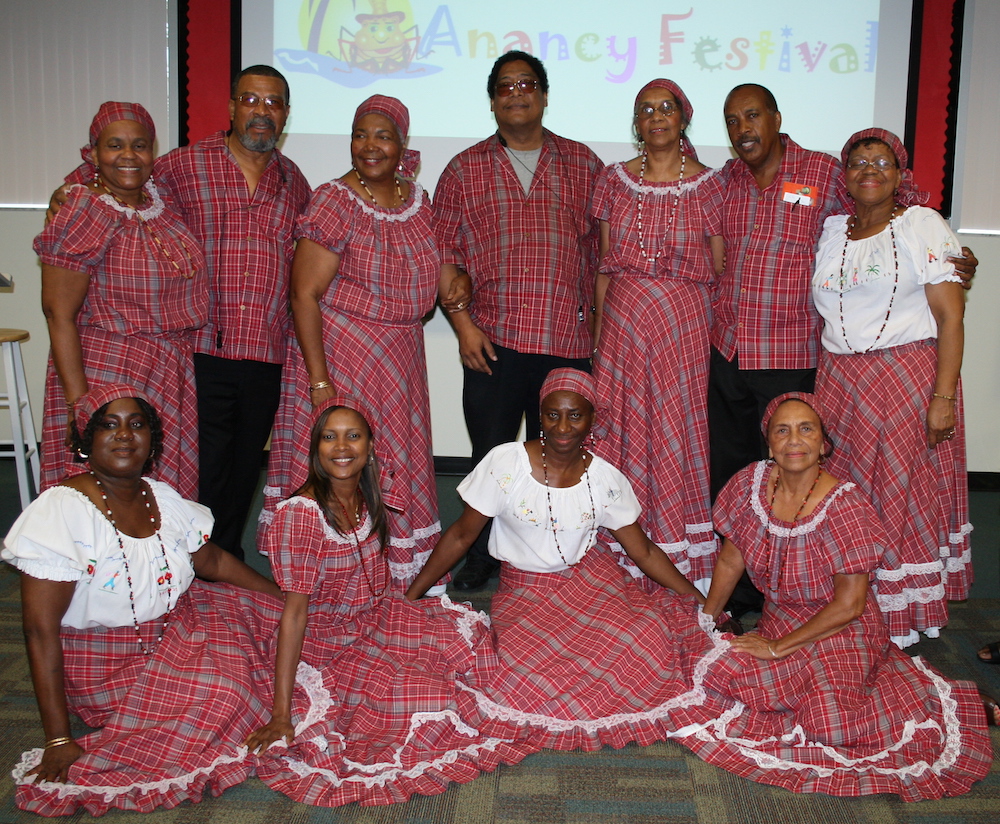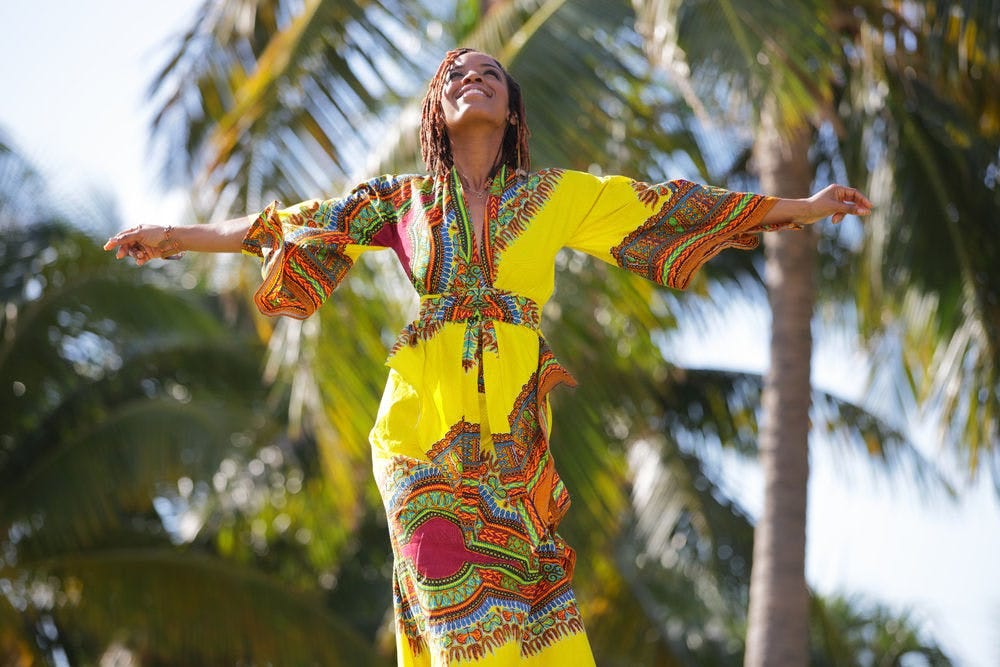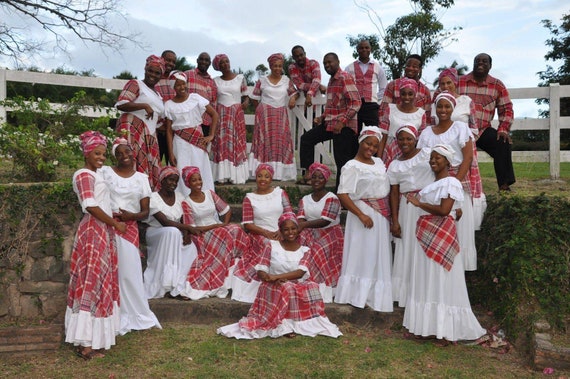Traditional Jamaican clothing, such as the bandana skirt and head scarf, the ruffled skirt and blouse, and the dashiki, reflects a blend of African and European influences. The vibrant colors and patterns hold historical and cultural significance, making them integral to Jamaica’s heritage.
These styles are a representation of the country’s rich history and are often worn during cultural celebrations and events. The traditional clothing of Jamaica is deeply rooted in the country’s history and culture. The bandana skirt and head scarf, the ruffled skirt and blouse, and the dashiki are some of the iconic pieces that showcase the fusion of African and European influences.
The vibrant colors and patterns used in these traditional outfits hold deep historical and cultural significance, making them an integral part of Jamaican heritage. These attire are not only a form of self-expression but also a celebration of the country’s rich and diverse cultural tapestry.

Credit: jamaicans.com
Table of Contents
ToggleRoots Of Jamaican Attire
Jamaican clothing is a vibrant reflection of the island nation’s rich cultural heritage. The roots of Jamaican attire can be traced back to various influences, including indigenous traditions, colonial history, and African heritage. Let’s explore the fascinating origins of traditional Jamaican clothing.
Indigenous Influences
The indigenous people of Jamaica, known as the Taíno, had their own unique clothing traditions. They crafted garments using natural materials such as woven fibers, animal skins, and feathers. These clothing items were often adorned with intricate designs and vibrant colors, representing their connection to nature and their spiritual beliefs.
The Taíno also used body paint and tattoos as forms of self-expression and cultural identity. These traditional practices continue to inspire modern Jamaican fashion, with designers incorporating indigenous motifs and natural elements into their creations.
Colonial And African Impact
During the colonial era, Jamaica was under the influence of European powers, particularly the British. The introduction of Western clothing styles and fabrics significantly impacted Jamaican attire. However, the African slaves brought to the island also played a crucial role in shaping the clothing traditions.
The African slaves infused their own cultural heritage into Jamaican clothing, incorporating vibrant colors, bold patterns, and intricate embroidery. They used fabrics like the ‘bandana,’ a plaid cotton material, which eventually became synonymous with Jamaican culture. The ‘bandana’ was originally used to make head ties and aprons for female Jamaican farmers and market vendors.
The fusion of African and European influences resulted in unique clothing styles like the ruffled skirts and blouses, dashikis, and the iconic bandana skirt and head scarf combination. These garments continue to be worn today, not only as a symbol of Jamaican pride but also as a celebration of the country’s diverse heritage.
In conclusion, traditional Jamaican clothing is a testament to the rich history and cultural diversity of the island. The indigenous influences, colonial impact, and African heritage all contribute to the unique and vibrant attire that represents Jamaican identity. Whether it’s the colorful patterns of the bandana or the intricate embroidery of the dashiki, each garment tells a story and connects Jamaicans to their roots.
The Quintessential Bandana
Symbolism And Usage
The bandana, also known as the ‘bandanna’ or ‘head tie,’ holds deep symbolism in Jamaican culture. Historically, it was worn by female farmers and vendors in the markets as a head tie and apron. The vibrant colors of red, yellow, and white reflect the island’s rich heritage, while the plaid cotton material symbolizes resilience and resourcefulness.
Modern Interpretations
In modern times, the bandana has transcended its traditional usage and has become a fashion statement, representing Jamaican pride and identity. It is not uncommon to see the bandana incorporated into various clothing items, such as skirts, dresses, and head wraps, adding a touch of Caribbean flair to contemporary fashion trends.
National Pride: The Quadrille Dress
In Jamaica, the Quadrille Dress holds a special place in the hearts of the people, representing national pride and cultural heritage. This traditional attire is deeply rooted in Jamaican history and is still worn with great reverence today. Let’s explore the design and significance of the Quadrille Dress, as well as the occasions where it is commonly worn.
Design And Significance
The Quadrille Dress showcases intricate craftsmanship and vibrant colors that reflect the fusion of African and European influences in Jamaican culture. The dress typically features a full, flowing skirt adorned with ruffles and layers, creating a sense of movement and grace. The bodice is often fitted, accentuating the wearer’s figure, while the sleeves can be long or short, depending on personal preference.
This traditional attire is made using the authentic Jamaican Bandana fabric, which is characterized by its plaid pattern in shades of red, yellow, and white. The Bandana fabric holds great significance as it is considered the unofficial national fabric of Jamaica. Originally, it was used to make head ties and aprons for female Jamaican farmers, but over time, it became a symbol of Jamaican identity and pride.
Occasions For The Quadrille
The Quadrille Dress is worn on various special occasions and cultural celebrations throughout Jamaica. It is particularly popular during festivals like Emancipation Day, Independence Day, and during Quadrille dance performances. The Quadrille dance itself is a traditional Jamaican folk dance that originated during the colonial era and is still cherished as a cultural treasure.
Many Jamaicans also choose to wear the Quadrille Dress at weddings, particularly those with a traditional or cultural theme. The dress adds an element of elegance and authenticity to the celebration, allowing individuals to connect with their heritage while celebrating love and unity.
Furthermore, the Quadrille Dress is often worn during Jamaican cultural events held abroad, allowing the diaspora to showcase their pride in their Jamaican roots. It serves as a powerful symbol of identity and belonging, bringing people together and fostering a sense of unity and community.
Whether it is a joyful celebration or a solemn occasion, the Quadrille Dress stands as a testament to the rich cultural heritage of Jamaica. It embodies the spirit of national pride, showcasing the beauty and diversity of Jamaican traditions. By wearing the Quadrille Dress, individuals not only honor their ancestors but also contribute to the preservation and promotion of Jamaican culture for future generations to come.
Rastafarian Influence On Fashion
The Rastafarian influence on fashion has had a significant impact on traditional Jamaican clothing. The Rastafarian movement, with its roots in Jamaica, has inspired unique styles and color schemes that have become synonymous with Jamaican fashion.
Colors And Their Meanings
The colors used in traditional Jamaican clothing hold deep symbolic meanings. The Rastafarian movement has popularized the use of red, gold, and green in clothing, which represent the blood of the martyrs, the wealth of the homeland, and the lush vegetation of Jamaica, respectively.
Adopting Rasta Styles
Adopting Rasta styles in clothing often involves incorporating these symbolic colors into the designs. Traditional Jamaican clothing, influenced by Rastafarian culture, embraces these vibrant hues, creating visually striking and culturally significant attire.
Jamaican Fashion Icons
Jamaican fashion icons are known for their vibrant and colorful traditional clothing, including the bandana skirt and head scarf, the ruffled skirt and blouse, and the dashiki. These styles incorporate a mix of African and European influences, reflecting Jamaica’s rich history and culture.
Jamaican Fashion Icons Jamaican fashion has come a long way since the days of traditional clothing like the bandana skirt and head scarf, the ruffled skirt and blouse, and the dashiki. Today, the island boasts a vibrant fashion scene that is influenced by both local and international trends. In this post, we’ll take a closer look at some of the Jamaican fashion icons who have helped shape this scene.Miss Lou’s Legacy
Miss Lou, born Louise Simone Bennett-Coverley, was a Jamaican poet, folklorist, and actress who was instrumental in promoting Jamaican culture and language. Her work had a profound impact on the island’s fashion scene, particularly in the use of traditional fabrics like the bandana. Today, you can see her influence in contemporary designs that incorporate bold colors and vibrant patterns.Contemporary Fashion Pioneers
Jamaica is home to a number of contemporary fashion pioneers who are making waves both locally and internationally. Some of the most well-known include:- Cedella Marley: The daughter of Bob Marley is a fashion designer in her own right, with a line of clothing inspired by her father’s music and Jamaican culture.
- Debbie Bissoon: Bissoon is the founder of KAJ Designs, a fashion label that specializes in resort wear and swimwear made from sustainable materials.
- Marcus Bird: Bird is the founder of Bird Apparel, a streetwear brand that blends Jamaican culture with contemporary fashion.

Credit: medium.com
Crafting Traditional Garments
Crafting Traditional Garments in Jamaica involves creating unique clothing pieces such as the bandana skirt, ruffled skirt and blouse, and dashiki. These garments showcase a blend of African and European influences, incorporating vibrant colors and patterns that reflect Jamaica’s rich history and culture.
Get inspired by the traditional clothing of Jamaica and embrace its vibrant heritage.
Traditional Jamaican clothing is a reflection of the island’s rich history and culture. Crafting these garments is an art that has been passed down through generations, with each piece showcasing the skill and creativity of Jamaican artisans. In this section, we’ll explore the materials and techniques used in creating traditional Jamaican clothing and the talented artisans behind the scenes.Materials And Techniques
The materials used in traditional Jamaican clothing are often inspired by the island’s natural resources. For example, the ‘bandana’ fabric, which is considered the unofficial national fabric of Jamaica, is a plaid cotton material with main colors of red, yellow, and white. This fabric is commonly used in creating the headscarf and skirt worn by Jamaican women. Other materials used in traditional garments include lace, linen, and denim. The techniques used in creating traditional Jamaican clothing are a blend of African and European influences. Some common techniques include hand-sewing, embroidery, and smocking. These techniques are often used to create intricate patterns and designs that are unique to Jamaican culture.The Artisans Behind The Scenes
The artisans who craft traditional Jamaican clothing are skilled and passionate about their craft. They often work in small workshops or from their homes, using traditional techniques to create one-of-a-kind pieces. Many of these artisans have learned their craft from family members or through apprenticeships, passing down their knowledge from generation to generation. These artisans take great pride in their work, often spending hours on each piece to ensure it meets their high standards. They pay close attention to detail, from selecting the right materials to ensuring the final product is well-made and durable. In conclusion, crafting traditional Jamaican garments is an art that requires skill, creativity, and dedication. The use of natural materials and traditional techniques, combined with the talent of Jamaican artisans, results in unique and beautiful pieces that are a true reflection of the island’s culture and history.Cultural Celebrations And Attire
When it comes to cultural celebrations and attire, traditional Jamaican clothing plays a significant role in showcasing the rich heritage and vibrant cultural identity of the island. From festivals and folk performances to national events, the dress codes reflect the unique fusion of African and European influences, creating a visually captivating and symbolic display of Jamaican traditions.
Festivals And Folk Performances
Traditional Jamaican clothing takes center stage during vibrant festivals and folk performances, where the colorful and intricate attire adds to the energy and spirit of the celebrations. The traditional bandana fabric, with its distinctive plaid pattern in red, yellow, and white, is a prominent feature in many of these events. It is often used to create head wraps, skirts, and other garments that contribute to the dynamic visual tapestry of Jamaican culture.
Dress Codes For National Events
National events in Jamaica come with specific dress codes that honor the country’s traditions and history. For formal occasions, men may wear the elegant and symbolic dashiki, while women opt for the ruffled skirts and blouses that exude grace and sophistication. The bandana skirt and head scarf are also popular choices, representing the deep-rooted connection to the island’s heritage.

Credit: www.etsy.com
Evolution Of Jamaican Clothing
Traditional Jamaican clothing has undergone a fascinating evolution over the years, reflecting the diverse cultural influences and historical significance of the island. From the vibrant colors to the intricate patterns, Jamaican clothing is a reflection of the nation’s rich heritage.
Influence Of Global Trends
The evolution of Jamaican clothing has not been isolated from the influence of global fashion trends. As the world became more interconnected, Jamaican fashion started incorporating elements from various cultures, creating unique and eclectic styles.
One such example is the dashiki, a loose-fitting, brightly colored garment that originated from West Africa. It quickly gained popularity in Jamaica, becoming a symbol of African heritage and cultural pride. The dashiki, with its bold patterns and comfortable design, continues to be a prominent feature in Jamaican fashion.
Another global trend that has influenced Jamaican clothing is the ruffled skirt and blouse. This style, with its feminine and playful aesthetic, has its roots in European fashion. The fusion of European influence with Jamaican flair has resulted in a distinctive look that showcases the island’s vibrant spirit.
Future Of Jamaican Fashion
The future of Jamaican fashion is bright, with the industry experiencing a resurgence in recent years. Designers are incorporating traditional elements into modern designs, creating a fusion of old and new that appeals to both locals and international fashion enthusiasts.
One of the exciting developments in Jamaican fashion is the increased use of sustainable and eco-friendly materials. Designers are embracing organic fabrics, such as the traditional ‘bandana’ fabric, which is made from plaid cotton. This not only promotes environmental consciousness but also preserves Jamaican heritage.
Furthermore, Jamaican fashion is becoming more inclusive and diverse, celebrating different body types and styles. Designers are creating clothing that caters to a wide range of individuals, ensuring that everyone can express their unique identity through fashion.
In conclusion, the evolution of Jamaican clothing showcases the island’s rich cultural heritage and its ability to adapt to global fashion trends. With a focus on sustainability and inclusivity, the future of Jamaican fashion looks promising, promising a vibrant and diverse fashion industry for years to come.
Frequently Asked Questions
What Is The Traditional Clothing In Jamaica?
Traditional Jamaican clothing includes the bandana skirt and head scarf, ruffled skirt and blouse, and dashiki. These styles combine African and European influences, with colors and patterns reflecting Jamaica’s history and culture. The bandana fabric, with its red, yellow, and white plaid design, is considered the unofficial national fabric.
Casual wear like tank tops and lightweight shirts are also popular in Jamaica. Reggae fashion often features loose pants, unique design shirts or jackets, and vibrant colors.
What Is The National Fabric Of Jamaica?
The national fabric of Jamaica is the ‘bandana’, a plaid cotton material with red, yellow, and white colors. It is considered an integral part of Jamaican heritage and is often used to make head ties and aprons for female farmers and vendors.
Traditional Jamaican clothing includes the bandana skirt and headscarf, ruffled skirt and blouse, and dashiki, which blend African and European influences and reflect the country’s history and culture.
What Kind Of Clothes Do You Wear In Jamaica?
In Jamaica, traditional clothing includes bandana skirts, ruffled skirts and blouses, and dashikis. These styles feature a mix of African and European influences with colors and patterns that reflect Jamaica’s history and culture. For everyday wear, lightweight and airy clothes like tank tops and cotton or linen shirts are popular choices.
What Is Reggae Outfit?
A reggae outfit typically consists of loose, comfortable cotton or linen pants, a stylish jacket, and vibrant colors inspired by nature.
Conclusion
Traditional Jamaican clothing is a beautiful representation of the island’s unique history and culture. From the bandana skirt to the ruffled blouse, these styles incorporate elements of both African and European influences. The use of vibrant colors and patterns creates a visually stunning and authentic look that is perfect for any occasion.
Whether you’re a native Jamaican or simply a lover of fashion, traditional Jamaican clothing is a must-have for your wardrobe.
